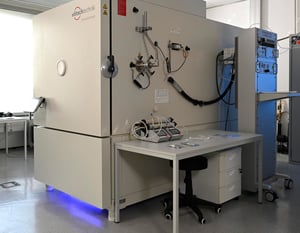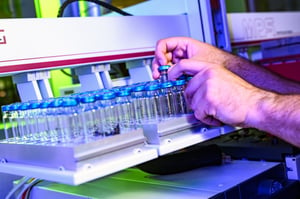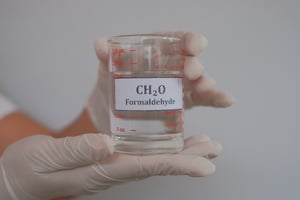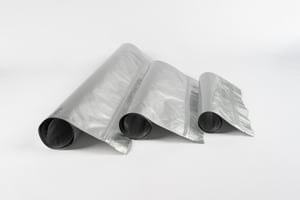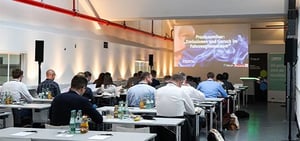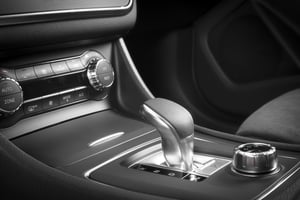
Fogging
Determination of the fogging behavior of materials used in vehicle interiors
FOGGING TEST IN THE
AUTOMOBILE INTERIOR
STONE IMPACT TESTS: RESILIENCE AND PROTECTION FOR LONG-LASTING COATINGS
Stone impact tests are an important method for evaluating the resistance of paintwork, particularly in the automotive sector, where surfaces are exposed to daily stresses caused by stones and dirt particles being thrown up. These tests simulate realistic scenarios in which mechanical influences are specifically simulated in order to test the resilience of painted vehicle parts such as bumpers or floor panels. The aim is to identify weak points at an early stage and to sustainably improve the quality of the coatings so that they remain durable and functional even under demanding conditions.
In accordance with DIN EN ISO 20567-1, standardized hard cast granules are shot at the test specimens at a defined pressure and angle in order to simulate the real stress caused by road dirt. The pressure of the shot is variable, as the speed of the granulate cannot be set directly in km/h. The test system is regularly calibrated and the granulate is routinely replaced to ensure reproducible results. Parameters such as grain size, bombardment quantity, angle and pressure are adapted to the respective standard and manufacturer specifications.
Once the tests have been completed, the extent of the damage is visually assessed and documented, taking into account the affected layers. For meaningful results, it is essential that the samples are delivered in a clean and undamaged condition. Shock-resistant packaging protects the samples during transportation, and accompanying documents with details of the coating and layer information facilitate test preparation.
The test parameters include the pressure, the grain size of the granulate, the bombardment angle and the number of samples. At least five samples are required per test series, with additional samples recommended for comparison tests. Shipment is made to our test center in shockproof packaging, accompanied by coating and material composition information to ensure comprehensive and accurate analysis. Our professional stone impact tests provide you with reliable results and increase confidence in the quality of your coatings.

Stone impact test methods
Fogging test methods
- DIN 75201-A (reflectrometric)
- DIN 75201-B (gravimetric)
- PV 3015 (Volkswagen)
- GMW 3235-A (General Motors Worldwide)
- PSA D45 1727
- and much more.
Are you looking for an exam? Standard? Specifications?
Accredited & certified tests
CONTACT OUR EXPERTS
Description. Lorem ipsum dolor sit amet, consetetur sadipscing elitr, sed diam nonumy eirmod tempor invidunt ut labore et
- Tab Title






- 01 Purpose of the stone impact tests
- 02 Test execution
Purpose of the stone impact tests
- Assessment of resistance: Checking how paintwork withstands mechanical influences such as stones thrown up and road dirt.
- Detection of weak points: Identification of coating defects to improve quality at an early stage.
- Simulation of realistic conditions: Simulation of everyday loads in accordance with DIN EN ISO 20567-1 for realistic results.
- Quality assurance: Ensuring the durability and protective function of vehicle paintwork.
- Compliance with standards and specifications: Testing of paintwork based on manufacturer-specific requirements and international standards.
Test execution
The stone impact tests are carried out in accordance with the DIN EN ISO 20567-1 standard in order to simulate realistic stresses caused by stones and road dirt being thrown up. Standardized chilled cast iron granulate is shot at the samples to be tested at a defined pressure and angle. The test system makes it possible to vary the pressure and therefore the speed of the granulate, as the firing speed cannot be set directly in km/h. This ensures precise adjustment of the test parameters. This ensures precise adjustment of the test parameters to real load situations.
In order to achieve reproducible results, the test system is regularly calibrated and the granulate is routinely replaced. Depending on standard or manufacturer specifications, parameters such as grain size, bombardment quantity, angle and pressure can be flexibly adjusted.
Once the tests have been completed, the extent of the damage is visually assessed. The affected layers are documented and the results analyzed in accordance with the normative specifications. To ensure reliable performance, it is important that the samples are delivered in a clean and undamaged condition. They are transported in shockproof packaging, accompanied by accompanying documents with details of the coating and layer information. This ensures that all relevant details are included in the test parameters and that a precise analysis is possible.
Frequently asked questions about the fogging test
The sample quantities required for a fogging test depend on the standard and the test method used. Here are the general guidelines:
1. standard DIN 75201 (type A and type B)
-
Type A (glass plate method):
A sample quantity of 10 cm² is typically required. The sample is placed on a heated plate in a sealed chamber and the volatiles released condense on a glass plate above. -
Type B (aluminum foil method):
Similar to type A, a sample volume of approximately 10 cm² is used. However, the volatile substances condense on a cooled aluminum foil.
2. standard ISO 6452 (international standard)
- Sample quantity:
Again, a sample size of about 10 cm² is typically required to evaluate the amount of volatiles released at elevated temperature.
3. other specific requirements
Depending on the specific requirements of the customer or OEM standards, sample quantities may vary. It is important to check the respective standards or test requirements carefully.
Method A - Reflectometric method:
- Principle: This method measures the change in reflectivity on a glass plate on which volatile components from the material sample are deposited.
- Procedure: A material sample is heated in a beaker while a glass plate above it is cooled to 21°C. The temperature difference causes the volatile components to condense on the glass plate. The reflectance index of the fogged glass plate is then measured to determine the amount of condensed material.
- Application: This method is particularly suitable for materials for which an exact determination of the optical fog effect is required.
Method B - Gravimetric method:
- Principle: This method measures the weight of condensed volatiles on an aluminum foil.
- Procedure: The material sample is heated in a beaker while an aluminum foil disc is cooled to 21°C. After 16 hours, the amount of condensed material on the foil is weighed.
- Application: This method is ideal for an accurate quantitative determination of the amount of condensed volatiles.
CONTACT US
CORROSION
Formaldehyd in Fahrzeugen: Herausforderungen für die Automobilindustrie
Read moreStellantis: Freigabe für Emissionsprüfungen erfolgreich (VIAQ)
Read moreVDA 277 vs. VDA 278: Was ist der Unterschied?
Read moreGeruchsunterschiede bei Polypropylen: Die Rolle von Faserverstärkung und Verarbeitungsparametern
Read moreWarum sind die Einheiten der Ergebnisse von Prüfungen der Werkstoffemissionen eigentlich so unterschiedlich?
Read moreGrenzwerte für Formaldehyd und Formaldehydabspaltern in Fahrzeugen
Read moreFREQUENTLY ASKED QUESTIONS ABOUT STONE IMPACT TESTS
The samples should be delivered clean, free from damage and contamination. Shockproof packaging protects them from damage during transportation. Information on the type of coating, coating system and coating process is necessary in order to optimally determine the test parameters.


